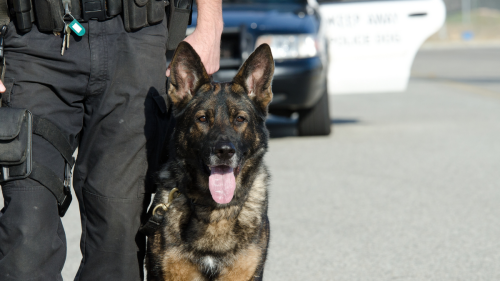By Sarah Roebuck
COLLEGE STATION-BRYAN, Texas — In times of disaster, the spotlight often falls on emergency responders, like paramedics, firefighters and police officers, as well as the K-9 units that assist them.
However, one group frequently overlooked in crisis situations are veterinarians, Texas A&M states. Veterinarians play a vital role in emergency situations, not only caring for the K-9 officers but also tending to the pets affected by disaster. That’s why in early May, Texas A&M Task Force 1, including K-9 Canyon and handler Christy Bormann, Texas A&M’s Veterinary Emergency Team (VET) Director Dr. Deb Zoran and the School of Veterinary Medicine’s Dean Dr. John R. August, visited Capitol Hill. They discussed with legislators the potential benefits of expanding their program to enhance disaster preparedness and response efforts nationwide.
During their visit to Capitol Hill, the team highlighted that as natural and human-made disasters grow more frequent and severe, the demand on community leaders, including veterinarians, to prepare and respond has intensified, straining local resources. VET has collaborated with various Texas jurisdictions to develop animal-focused emergency plans.
“The Texas A&M Veterinary Emergency Team has been a model for animal-focused disaster response for over a decade. With federal funding, the VET can play a leadership role in the development of a nationwide emergency management program that serves both federal search and rescue teams and animal owners across the country,” August said. “The VET’s clinical education component attracts veterinary students from across North America to learn from Texas A&M’s experts; with the establishment of a federal program, there is potential for training additional veterinary students and practicing veterinarians across the country.”
Since its inception in 2010, the Texas A&M Veterinary Emergency Team (VET) has responded to 26 disasters across Texas and beyond, including the severe wildfires in the Texas Panhandle earlier this year. During these fires, the VET triaged nearly 700 cattle and treated 271 animals for injuries and smoke inhalation. They also provided vital nutritional support to calves impacted by the loss of their mothers or injuries preventing nursing, thus protecting a crucial part of the agricultural industry. Additionally, the VET supported search and rescue dogs from Texas A&M Task Force 1 and Texas Task Force 2, who were involved in operations across more than 200 devastated homes.
The Homeland Security subcommittee of the House Appropriations Committee is set to review a funding request for fiscal year 2025 to establish a national network of Veterinary Emergency Teams (VETs). These teams will aid state and local governments and nonprofits with veterinary aspects of recovery efforts. The funding would enable Texas A&M to continue supporting the Federal Emergency Management Agency’s response and recovery initiatives.






